Historical Vehicles for Examples of Spiritual Experiences, 1 Nephi 16 – ch. 18
This posting will be unsettling to many, but it should not be. It will be if the reader thinks the following analysis should be found in a lesson manual. It is not. This analysis is mine, and I think it is right. But my opinion is loosely held, so criticize me with comments if you think I am wrong. If I am wrong, I want to be straightened out. Chapters 16 through 18 of First Nephi provide insight into what a spiritual experience is by using historical events as the vehicle for this message. Why Laman and Lemuel could say Nephi lied about seeing an angel (yes, Nephi records this belief by his brothers), how Nephi could say he had, and the important allusion to Elijah's experience are covered. Hebrew metaphysics is reviewed, as well, so that the reader can appreciate what is happening, the message carried by the events in these chapters. This posting does not cover all that can be said about these chapters. My Exegesis of the Book of the Book of Mormon, which is still in manuscript form, has much more. The most important part, in my view, is here: the allusion to Elijah's experience as recorded in 1 Kings 19.
1 Nephi 16:6–ch. 18
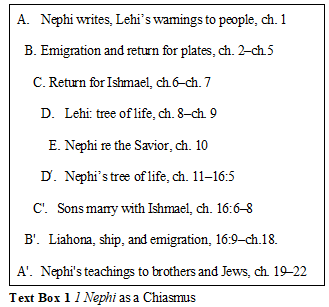 The historical information in this section1 forms the basis of important doctrinal teachings. But this historical information is, itself, a witness of the reality of Joseph Smith’s translation of an ancient record. While the doctrinal teachings are more important from an eternal perspective, the historical information provides a believable setting for the book as a whole, a fertile plot for planting the seed of faith.2 Indeed, the historicity of the Book of Mormon what these chapters record cannot be lightly discarded. Thus, these chapters give the Book of Mormon the same stature as the Bible; both are books written by ancient writers, so a modern reader is compelled to accept the historicity of these books. Whether the modern reader accepts what is taught, however, is a matter of free agency.
The historical information in this section1 forms the basis of important doctrinal teachings. But this historical information is, itself, a witness of the reality of Joseph Smith’s translation of an ancient record. While the doctrinal teachings are more important from an eternal perspective, the historical information provides a believable setting for the book as a whole, a fertile plot for planting the seed of faith.2 Indeed, the historicity of the Book of Mormon what these chapters record cannot be lightly discarded. Thus, these chapters give the Book of Mormon the same stature as the Bible; both are books written by ancient writers, so a modern reader is compelled to accept the historicity of these books. Whether the modern reader accepts what is taught, however, is a matter of free agency.
What is taught in this section of the Book of Mormon is more important, of course, than the compelling reality of the book’s historicity, the events recorded being the vehicle for or incidental to the teachings.
 The Liahona is an example. The Liahona is introduced when the emigrants leave the Valley of Lemuel.3 Knowing where the Valley of Lemuel was gives context and makes the need for the Liahona understandable. While the description of this valley is part of what makes the historicity of the Book of Mormon patent, the historicity of the book is not the important part. It is what the Liahona represents rather than what it was.
The Liahona is an example. The Liahona is introduced when the emigrants leave the Valley of Lemuel.3 Knowing where the Valley of Lemuel was gives context and makes the need for the Liahona understandable. While the description of this valley is part of what makes the historicity of the Book of Mormon patent, the historicity of the book is not the important part. It is what the Liahona represents rather than what it was.
Still, what it was is interesting. The Liahona is described as a ball of curious workmanship, and various theories have been advanced over the years as to its construction and method of operation. One of the most plausible explanations of the operation and design of the Liahona was published in an article by Robert M. Bunker.4
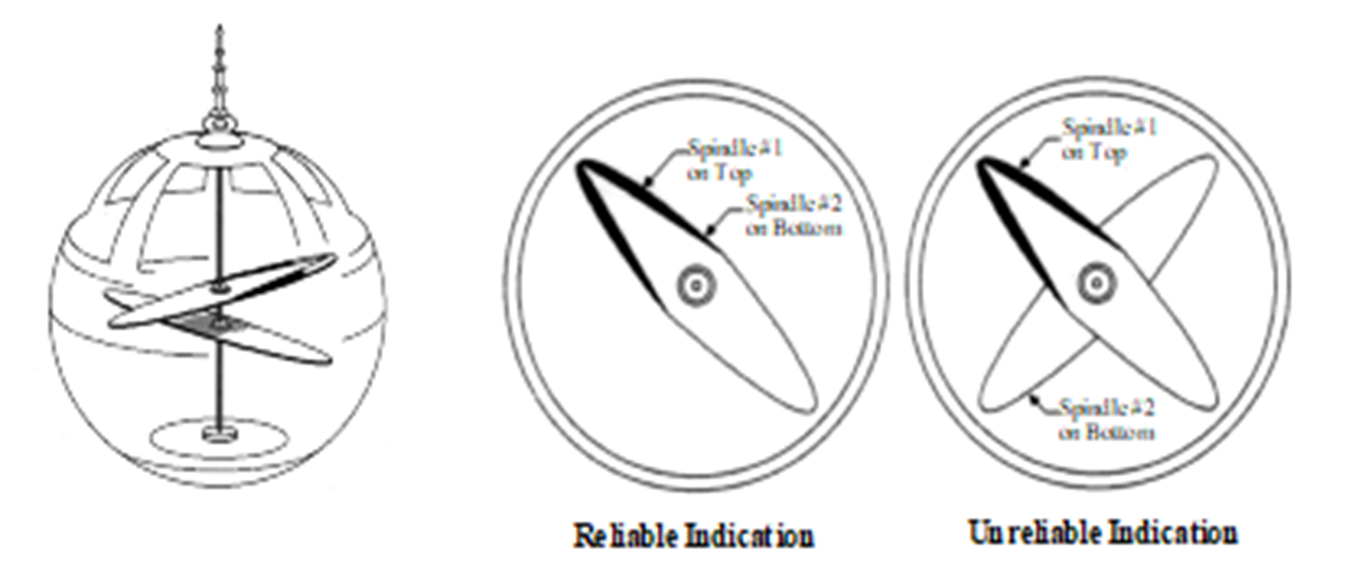 The Liahona was given by the Lord as a communications device for Lehi to determine the appropriate direction of travel. This device contained two pointers, only one of which was necessary to provide directional information. But the Liahona was more than just a simple compass in function, for it additionally required faith for correct operation. Since a single pointer always points in some direction, the additional pointer was necessary to indicate whether or not the first pointer could be relied upon. This proposed purpose for the second pointer conforms to a well-established engineering principle used in modern fault-tolerant computer systems called voting, in which two identical process states are compared and declared correct if they are the same, and incorrect if they are different. Hence the second pointer, when coincident with the first, would indicate proper operation, and when orthogonal, would indicate non-operation.
The Liahona was given by the Lord as a communications device for Lehi to determine the appropriate direction of travel. This device contained two pointers, only one of which was necessary to provide directional information. But the Liahona was more than just a simple compass in function, for it additionally required faith for correct operation. Since a single pointer always points in some direction, the additional pointer was necessary to indicate whether or not the first pointer could be relied upon. This proposed purpose for the second pointer conforms to a well-established engineering principle used in modern fault-tolerant computer systems called voting, in which two identical process states are compared and declared correct if they are the same, and incorrect if they are different. Hence the second pointer, when coincident with the first, would indicate proper operation, and when orthogonal, would indicate non-operation.
Bunker’s article proposes designs indicating the function of the Liahona as a compass with a voting, second spindle. Two aligned spindles was not confusing, but spindles pointing in different directions was. In addition to considering the operation of the spindles, the article by Bunker deals with design features, like the odd number of openings to view the spindles, the application of this mechanical voting in modern equipment, and the writing the appeared on the exterior, probably not the spindles, of the Liahona, itself.
The Liahona was kept by the Nephites. Eventually, Moroni placed it in the stone box where Joseph Smith found the gold plates from which the Book of Mormon was translated. It was one of the objects shown to the three witnesses to the Book of Mormon, to wit, the plates, the breastplate of Laban, the sword of Laban, the Urim and Thummin given to the brother or Jared, and the Liahona.5
The next event after the Liahona is the broken-bow experience, which is the vehicle for describing the murmuring and afflictions among Lehi’s family, the need for faith for the Liahona to work.
The historicity of the Book of Mormon becomes clear when the family traveled to a place called Nahom after the broken-bow experience. The approximate location of Nahom is known because of clear and convincing evidence, to borrow a legal standard. The evidence consists of what has been discovered about Nahom. First, two altars have been found near San’a, Yemen, with the name Nahom inscribed in Arabic. There have been two such altars found, and they may be called the first hard evidence of the historicity of the Book of Mormon. The Book of Mormon says Nahom was already named when when Lehi and his family arrived,6 so it was place that existed, which leads to the second evidence. There is a map from 1763 that has a place name equivalent to Nahom.
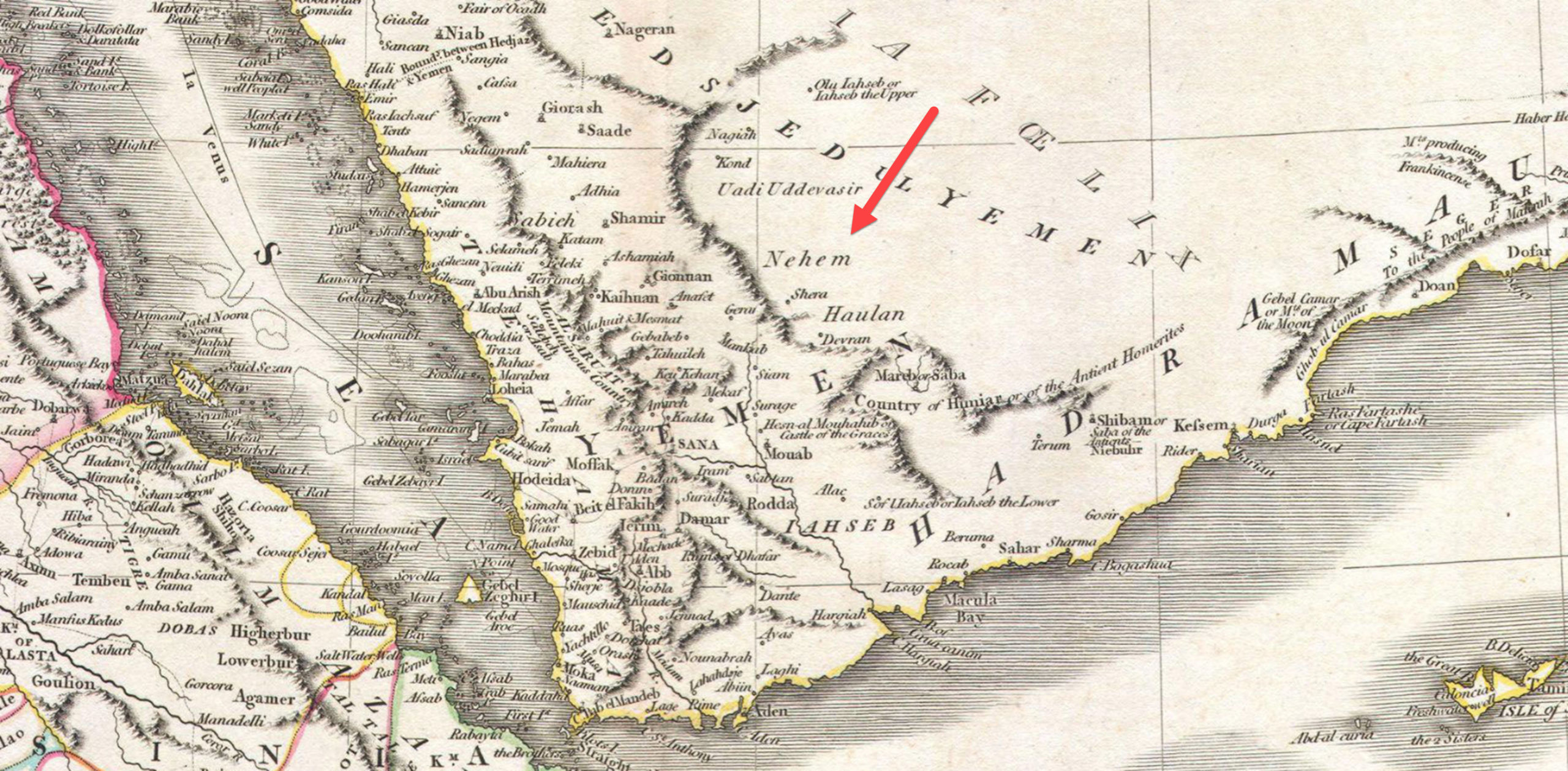
The map, shown above, was prepared as part of a scientific expedition sent out by King Frederick V of Denmark. Nehem appears on the map as a small administrative district or tribal region.7 The Nehem on this map is, convincingly, the Nahom of the Book of Mormon, the difference in the spelling being a matter of phonetics from the translation of Arabic into the English used on this map and problems with spelling that exist for all ancient texts.8 his map was discovered after the article published by the Hiltons describing Lehi’s probable route, and requires only a slight correction to the map produced by the Hiltons.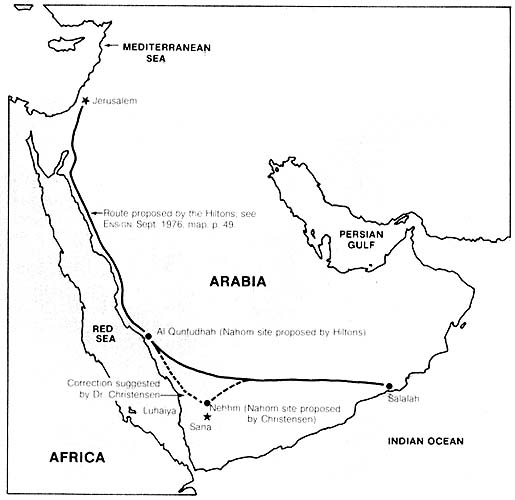
The altars found in the Nahom area are more provocative. The first of these burial altars or tombstones was noticed by S. Kent Brown, a professor of Ancient Scripture at BYU in 1999.9 Warren Aston went to Yemen in 2000 and found the three altars with the same inscriptions on them dating from the Seventh and Sixth Centuries BC.10 Warren Alston is shown by an altar with the Nahom or Nehen inscribed on it.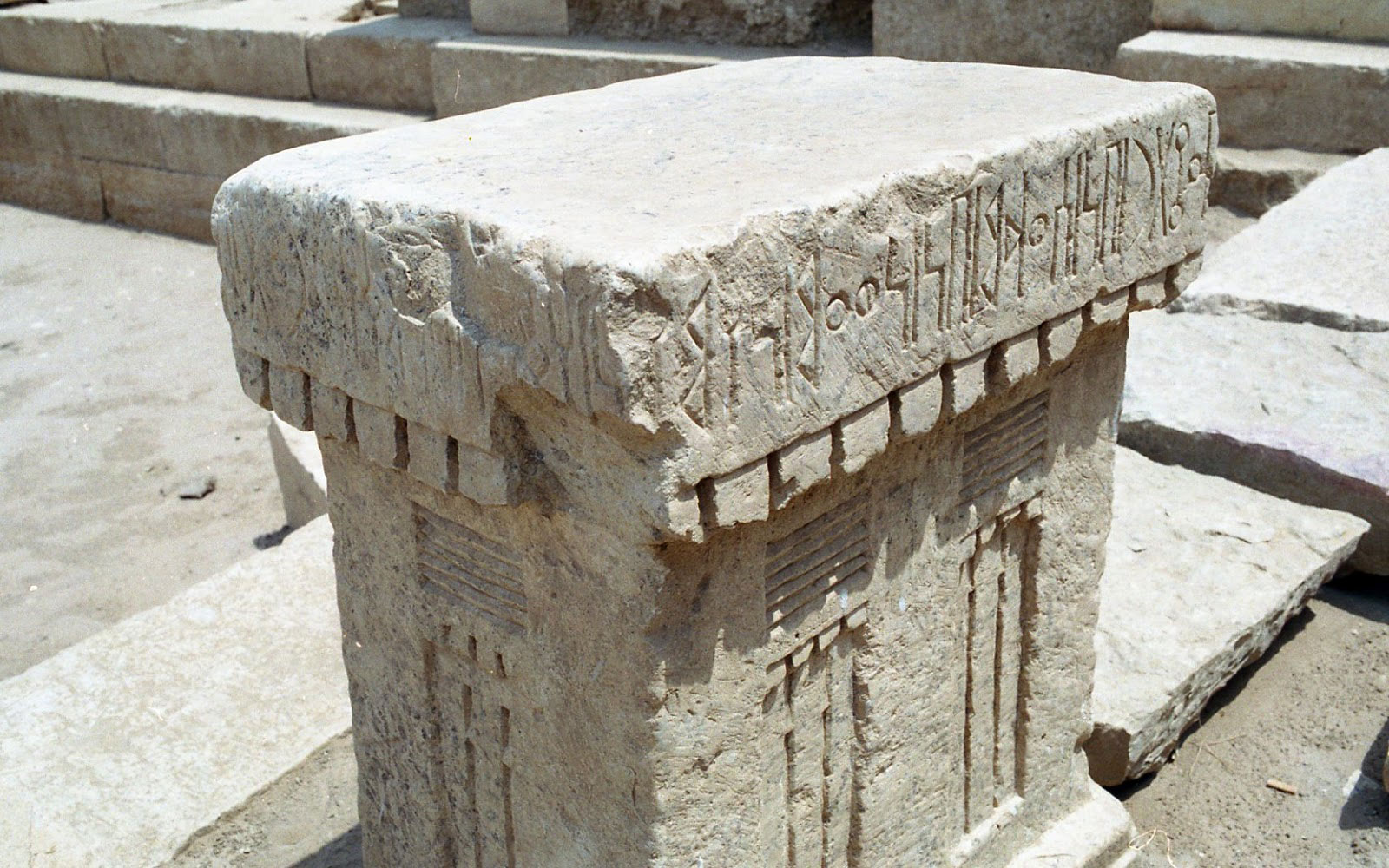
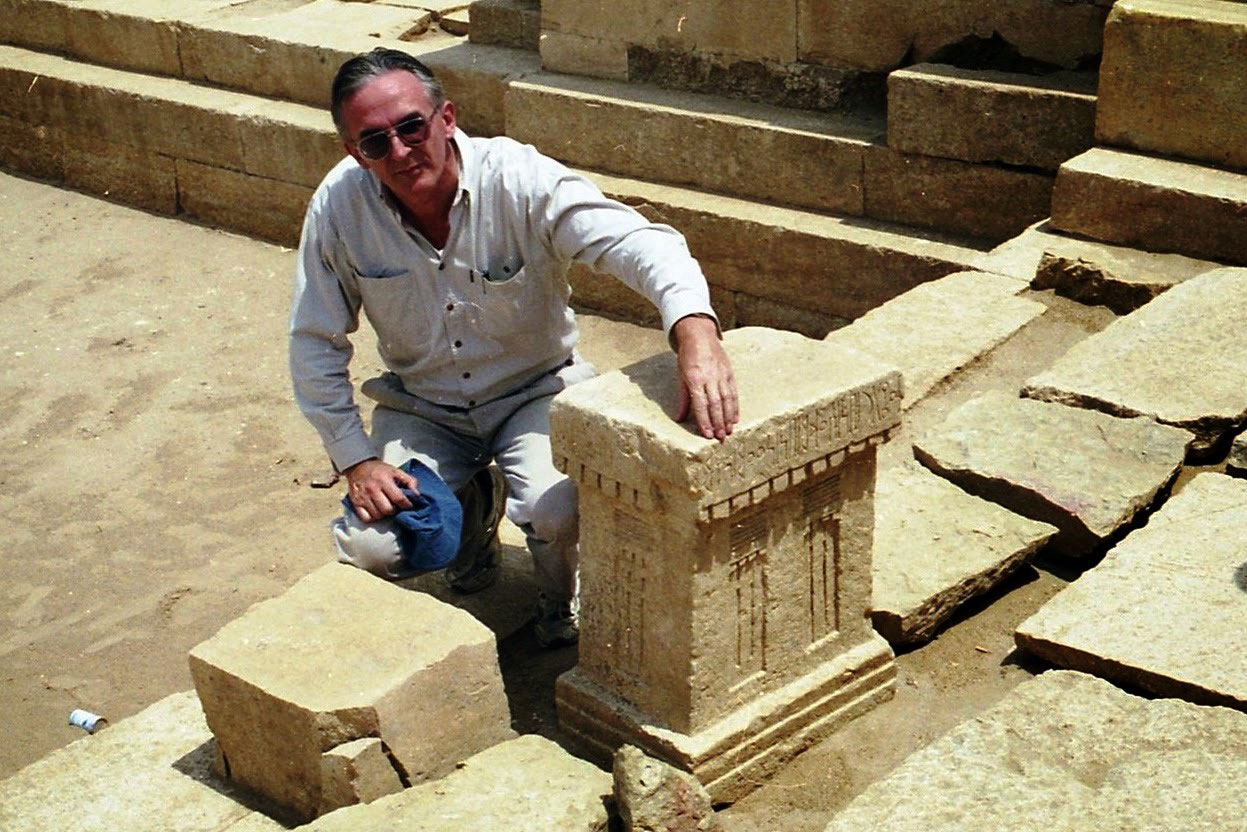 Nahom was an ancient burial site that merited a record because Nephi knew that he would never return to the place and, therefore, carefully recorded it as the burial location for his father-in-law and the grandfather to his children.
Nahom was an ancient burial site that merited a record because Nephi knew that he would never return to the place and, therefore, carefully recorded it as the burial location for his father-in-law and the grandfather to his children.
We now come to the third aspect of Nahom—that it was a place of burial. As Nephi wrote his account years later in the New World, he surely realized that he and his family would never return to the burial place of Ishmael, his father-in-law and a grandfather to his children; thus he was careful to place on record the name of that place. . . .
. . . the ancient past of southern Arabia tells us rather clearly that the origin of the name Nahom is connected to a place of burial. And its name is also tied to the Nihm tribe living in the area. Scholars have recognized for some time that the Semitic roots of the name Nahom closely relate to sorrow, hunger, consoling, and mourning, obviously very appropriate for a place of burial, and may therefore reflect the origin of the Hebrew name used by Nephi.
. . . . While there are isolated burial tombs scattered throughout the Nahom region, this vast cemetery covering many square miles and numbering many thousands of tombs is the largest burial area known anywhere in Arabia.11
There have been more than three thousand tombs identified in the vast burial field identified as Nahom, the land of the tribe with the same name, dating from 3000 bc.12
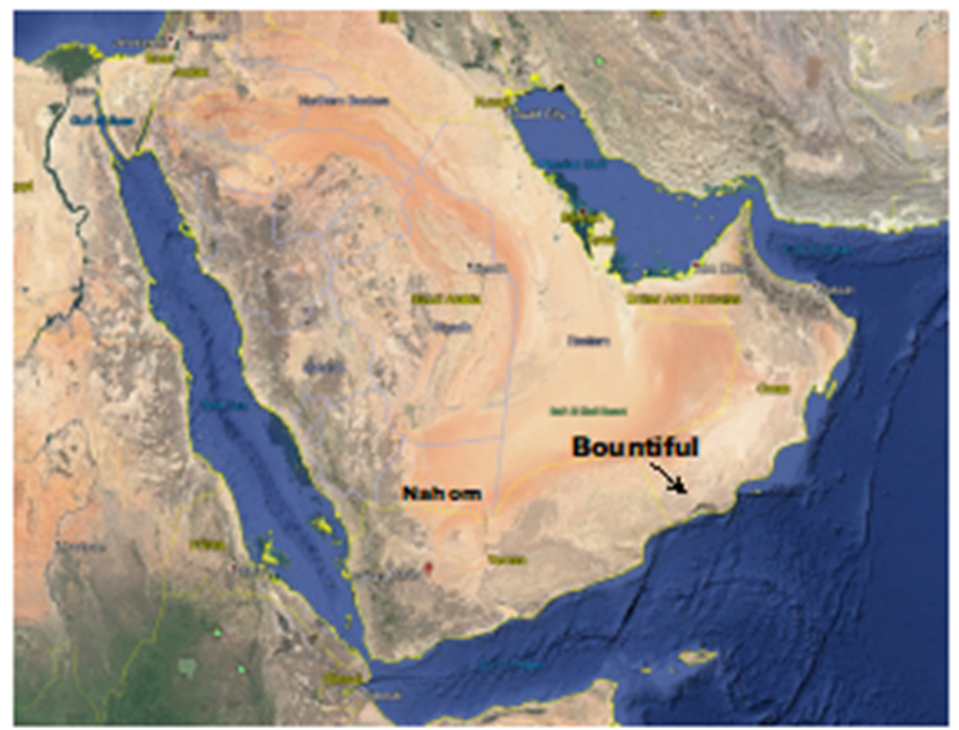 The first five verses of chapter seventeen related the nearly eastward travel when Lehi’s family left Nahom, which was a tribal area without set boundaries, for the place they called Bountiful, where it was verdant with trees used to build the ship for passage to the Americas. There is only one place on the shores of the Arabian Peninsula where this place existed and still exists, and the travel to that place was through a vast and empty quarter of the desert, not along the frankincense or trade route near the coast.
The first five verses of chapter seventeen related the nearly eastward travel when Lehi’s family left Nahom, which was a tribal area without set boundaries, for the place they called Bountiful, where it was verdant with trees used to build the ship for passage to the Americas. There is only one place on the shores of the Arabian Peninsula where this place existed and still exists, and the travel to that place was through a vast and empty quarter of the desert, not along the frankincense or trade route near the coast.
But it is unlikely Lehi took his people along the frankincense route because of the parenthetical about building fires.13 Lehi was not in a caravan with its associated safety, so he avoided discovery by the marauding tribes and robbers by staying off the trade route.
Having dealt with the route and the compelling evidence of the historicity of the Book of Mormon, it is time to turn to the important doctrinal teachings. The reproof Nephi gives his brothers in 1 Nephi 17:45 is archtypical of Elijah’s still-small-voice experience as he hid in a cave.14 so the meaning of still small voice must be understood. The following table compares Elijah’s experience with Nephi’s.15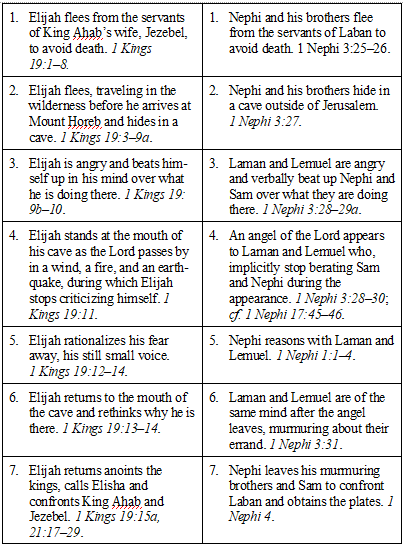
The allusion to Elijah can be missed if one is reading too quickly or is not familiar with Elijah’s experience at the mouth of the cave where he fled to avoid death at the hands of Jezebel’s servants. The problematic part for most readers of the Book of Mormon is Part 4 in this table. The Lord did not actually pass by the mouth of the cave where Elijah was hiding even though the scripture says the Lord was in these natural phenomenon that passed by the cave.16 Most reading the account of the brothers hiding in a cave, however, visualize an actual angel, in propria persona, appearing to the four brothers rather than an appearance via a storm or other natural phenomenon. Nephi’s the metaphysical paradigm made an angel in a storm the same as the presence of an angel the same way the Lord was present in the storm at the mouth of Elijah’s cave. Nephi uses Elijah’s experience to import the numinous qualities that attended Elijah’s revelation, so the appearance of an actual angel in the face of Laman and Lemuel’s continued murmuring or arguing immediately after the angel taxes credulity.17 Indeed, those who first read this experience and think there was an actual appearance of an angel are incredulous because they cannot reconcile the continued contumacy of the older brothers with an actual appearance.18
The inconsistency of Laman and Lemuel’s actions evanesces when the experience is recognized as an Elijah-like experience where the angel appears and speaks via natural phenomenon rather than in propria persona.19 after all, one can easily ignore signs and wonders just like the Nephites forgot signs and wonders, being less astonished at a sign or wonder, so they were hard in their hearts and blind in their minds.20
An important point is informative before comparing Elijah’s experience with what is recorded in the Book of Mormon. Yes, Nephi recorded the appearance of an angel at the cavity in the rock between the second and third attempts to get the plates. But only Nephi was aware of or saw the angel in the events that transpired there. Laman and Lemuel did not believe Nephi had seen an angel and accused him of lying about it.
[T]hey wanted to return again to Jerusalem. And Laman said unto Lemuel and also unto the sons of Ishmael: Behold, let us slay our father, and also our brother Nephi, who has taken it upon him to be our ruler and our teacher, who are his elder brethren.
Now, he says that the Lord has talked with him, and also that angels have ministered unto him. But behold, we know that he lies unto us . . . .
And thou [speaking of Nephi] art like unto our father, led away by the foolish imaginations of his heart; yea, he hath led us out of the land of Jerusalem, and we have wandered in the wilderness for these many years . . . .l21
Laman and Lemuel thought Nephi was making up this angel stuff. They thought he was imagining it. But looking at Nephi’s writing from the Hebrew metaphysical perspective vis-à-vis the allusion to Elijah clarifies what happened.
The allusion to Elijah is explicit because Nephi uses the phrase still small voice, a biblical hapax legomenon found only in the Elijah experience as recorded in the King James version of the Bible. The fact that Nephi uses this term in reference to his brothers’ experience with an angel cannot be disregarded.22 But clarity is added if what Nephi says is reformatted to show the couplets Nephi used by Nephi in 1 Nephi 17:45:
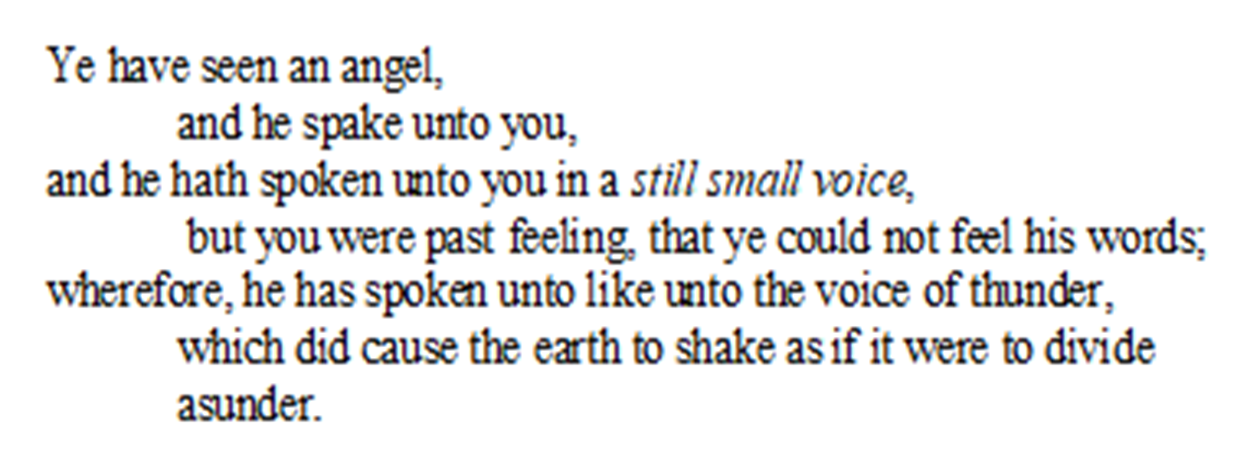
The first couplet in the foregoing cannot be taken literally, because still small voice is presented in the second couplet to explain how the angel spoke. The brothers, presumably, understood that thoughts and reality had no separate existence in Hebrew metaphysics, but that does not mean they understood what Nephi was telling them. Still small voice compels the conclusion that Nephi is alluding to Elijah’s experience, so the angel appearing to Laman and Lemuel was manifest in some natural phenomenon that interrupted Laman and Lemuel’s berating of Sam and Nephi. The harsh words occurred while Laman and Lemuel were smiting Sam and Nephi with the rod of their mouth; Laman and Lemuel were yelling at Sam and Nephi.23 One should not quickly conclude that the brothers actually spurned an audible voice; rather, it is more plausible that they had thought about the Lord and even witnessed dramatic events—the voice of Elijah’s thunder and wind but still chose a different path—which resulted in Nephi’s incredulity because Nephi could not understand how they did not connect the storm to an angel’s intervention.24
The word feeling in this context refers, of course, to the sense Laman and Lemuel were not making—not recognizing—of the angel’s intervention. One of the many definitions of feeling is “An idea, belief, or sense (especially a vague or irrational one) that a particular thing is true; an impression that something is about to happen or is the case; an intuition about something.25 It is wrong to conclude that this failure to recognize or sense or feel was some sort of physical or emotional sensation.
Parsing what Nephi says about the disposition Laman and Lemuel militates in favor of reading the appearance of the angel as a reference to natural phenomenon. First, Nephi tells his brothers that they are wicked because they do not remember the Lord, and, then, he gives them evidence of not listening when the Lord’s angel spoke to them. This explanation is a chiasmus, so the cognate parts of the chiasmus explain each other. First, there is a conclusion, which is followed by the explanation via balanced strophes. Strophe 1 is the cognate of Strophe 4: they say the same thing, as do strophes 2 and 3. Reformatting Nephi’s explanation makes the writing easier to understand; in other words, gives sense to the words that is otherwise easily overlooked. Nephi begins at 1 Nephi 17:45-46a with his conclusion, and strophes 1 through 4 are the evidentiary support before Nephi declaims what Laman and Lemuel knew: the power of the Lord over the very elements.
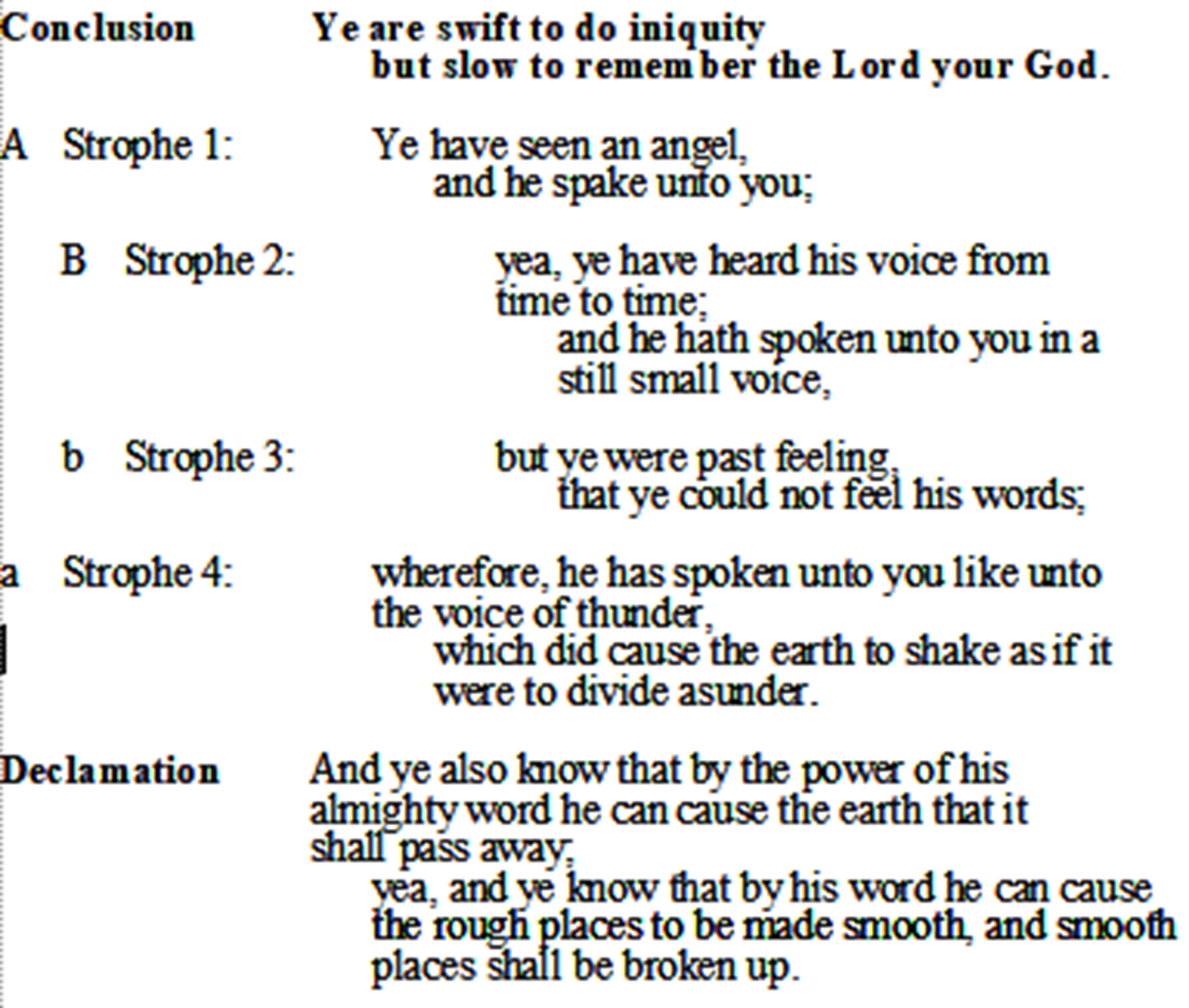
The evidentiary support for Nephi’s conclusion explains how it is that Laman and Lemuel were unaffected even though they saw an angel who spoke to them; i.e., the angel was present when the brothers, borrowing from Elijah’s experience, hid in the cavity in the rock to escape death at the hands of Lehi’s cohort. The angel spoke to them in a still small voice, strophe two, which they did not hear because they were past feeling—past believing—so they did not connect the storm with the voice of the angel, strophe three, which allowed them to deny it. But, strophe four, the angel is described as speaking through the voice of natural phenomenon that they should not have denied, because they knew—understood the idea that—the Lord controlled the elements. In other words, Laman and Lemuel’s reaction to the voice of the angle in the storm was a hardened or hard-hearted denial of the Lord’s power. Neither Elijah nor Nephi misunderstood, so they acted accordingly.26
Strophe two uses the term still small voice. This phrase is an hapax legomenon in the Book of Mormon and the King James Version of the Bible.27 It, likewise, appears only once in the Doctrine and Covenants.28 The only way this term can be in the Book of Mormon and the Doctrine and Covenants is because Joseph Smith imported the term from the King James Version of the Bible. It is imperative, therefore, that the biblical meaning of this term is understood so the reader of the Book of Mormon and Doctrine and Covenants can know what is intended.29 The obvious use of this unique phrase is the allusion to Elijah’s experience at the cave where he was, like Lehi’s sons, hiding from Jezebel’s soldiers sent to kill, just like Lehi’s sons where hiding in a cave—there are no such caves around Jerusalem, but the actual word Nephi uses is cavity of a rock rather than cave—from Laban’s cohort sent to kill them.
The Hebrew words from which still small voice was translated by the King James translators are קל דּממה. The first word, דּממה, is a feminine term.30 and appears only three times in the Hebrew Bible, the Elijah experience at the cave in 1 Kings 19, a Psalm, and once in Job.31 The use in 1 Kings is the important use. The use in Psalm 107 is an ordinary use that is not elucidating. But the use in Job is illuminating.
The usage in Job occurs during Job’s interview by Eliphaz when this supposed friend uses the scriptures to justify the judgments against Job. Eliphaz says he has had the spirit tell him Job is getting what he deserves on account of his wickedness, an experience so profound Eliphaz got gooseflesh:
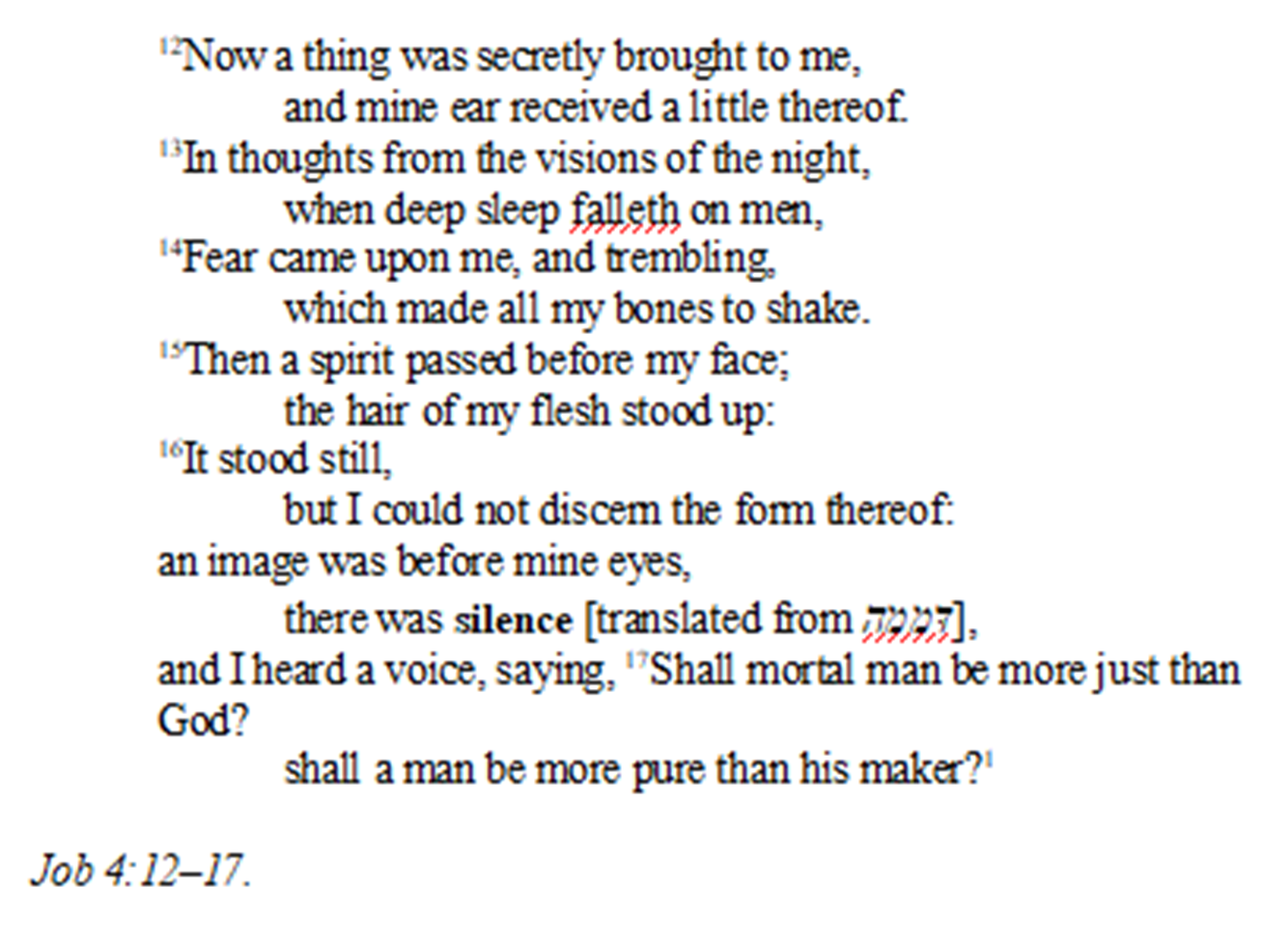
The scripture continues as Eliphaz continues to judge Job. Eliphaz’ judgmental propensity is a caricature for the pontificating, condescending, self-righteous individual who employs reasoning based on the scriptures to support his not-so-veiled and uninspired judgment of individuals who are suffering, like Job. Eliphaz sees Job as an obviously wicked man who is, therefore, a deserving victim of the plagues that beset him.
How Eliphaz uses the scriptures about the still small voice is wrong, albeit plausible. It is wrong because there was no voice that spoke to Elijah the way Eliphaz reads the figure of speech. Eliphaz’ reading, though, appears plausible, because Eliphaz applies what he sees in Elijah’s experience to himself, not understanding that Elijah figured out what he should do for himself and was not told by the Lord. So Eliphaz uses this Elijah-like experience to portray himself as righteous enough that the Spirit passed before him (like the Lord passing before Elijah via the natural phenomenon), which gave Eliphaz a frisson such that he had goose bumps like those described by many Church members today who have had what they think is a visitation of the Spirit). The voice Eliphaz heard was his own thoughts, just like Elijah, but the voice was judgmental, which the Lord would not induce Eliphaz to think. Eliphaz, in other words, is the judgmental and wicked in his judgment, but he takes refuge in the voice that he says told him of God’s judgment against Job.
Nephi’s use of still small voice should not be taken literally. Nephi is saying there was an angel who spoke via an unmentioned natural phenomenon during Nephi’s verbal beating by the rod of the mouths of Laman and Lemuel, harsh words.33 Nephi’s incredulity is because Laman and Lemuel did not make the connection between the Lord’s power as manifest by the natural phenomenon and the ability to carry out the Lord’s errand.34 Elijah witnessed similar natural phenomenon with effect, because he reacted differently than Nephi’s brothers. Elijah listened to the voice of his calm contemplations, which were supported by the witness of the Lord’s power in the natural phenomenon about him. And Nephi, no doubt, was similarly bolstered by the show of the Lord’s power just as was Elijah, and this bolstering allowed him to return, confront Laban, and get the plates..
The allusion to Elijah’s experience is, further, supported by the fact that a few verses before reference to the angel who appeared to Laman and Lemuel there is a reference to the Israelites leaving Egypt, “And he did straighten them in the wilderness with his rod; for they hardened their hearts, even as ye have.35 The theme that runs through this series of verses in chapter seventeen is the ruling power of the Lord, the earth being his footstool.36
Understanding Elijah’s experience is aided by understanding the Hebrew philosophical paradigm. Unlike the Greek paradigm, which has been adopted in the West, the Hebrews did not separate the idea of something from the thing itself. Under this paradigm, a wise man’s thoughts are the same as the voice of the God, and thinking of the appearance of an angel is the same as an appearance of an angel.
No wonder, then, that in the orations of the prophets of Israel, wisdom gained from experience, and from reasoning based on experience, at times becomes interchangeable with having heard God’s voice. Consider, for example, the following passage from Jeremiah [which is reformatted here to show the distich strophes]:
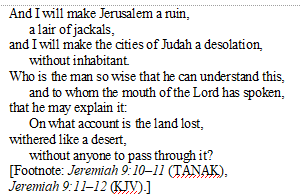
Here, “the man so wise that he can understand this” is invoked in parallel with the man “to whom the mouth of the Lord has spoken,” as if the appearance of understanding the mind of the individual is the same as God’s speech. [Explanatory footnote omitted.] We find a similar construction in Isaiah, who looks forward to the coming of the future king, upon whom will rest the spirit of God. And yet this “spirit of God,” as Isaiah understands it, is itself indistinguishable from the wisdom, understanding, and the ability to judge wisely and with justice:
And the spirit of the Lord will rest upon him: The spirit of wisdom and understanding, the spirit of good counsel and bravery, the spirit of knowledge and of the fear of the Lord, and his delight shall be in the fear of the Lord. [Footnote: Isaiah 11:2–3; many other examples are cited in this footnote, the author concluding, “there seems to be no boundary at all between that knowledge which is native to individuals and that which is granted by God.37
Knowing that reasoning based on experience and knowledge is “interchangeable with having heard God’s voice,” the context of the still-small-voice metaphor makes sense without the constructions offered by those who want an actual voice speaking to Elijah. Elijah hid himself in a cave after he fled for his life from Jezebel. He was anxious and depressed. He wanted to die. He dithered as he hid. But he was awed by the power of the Lord as he witnessed the natural phenomenon. So his thoughts were turned to the Lord’s power.38 The recitation that the Lord was not in these phenomenon even though we are told He was must mean that it took Elijah some time to realize that the power of the Lord he had just witnessed would preserve him as the Lord’s servant. It was then that the scripture says “and after the fire a still small voice.” It is this still small voice—Elijah’s own thoughts—that provokes Elijah to action. Laman and Lemuel, of course, had no such thoughts subsequent to the appearance of an angel via the manifestation of natural phenomenon. They did not hear of the voice of the angel nor see the angel in the phenomenon that caused them to cease beating Sam and Nephi with the rod of their mouth.
Using the pattern of Elijah’s revelatory experience to underscore Nephi’s own is typical of the Hebrew/Nephite approach to writing. Allusions and archetypes are comparative figures of speech that affect the writing. Nephi’s still-small-voice experience is like Elijah’s, so the numinous qualities of Elijah’s experience are imported into Nephi’s. This employment of this sort of typology is part of biblical and Book of Mormon style.39 It involves literary license with the facts to conform to the message.
The experience on the ship is a reiteration of the disbelief of Laman and Lemuel and the resulting abuse of Nephi and the danger of natural phenomenon. The effect of the natural phenomenon on Laman and Lemuel is more explicit, because Nephi records that their fear of dying is what caused them to untie Nephi, resulting in the abatement of the storm.
And it came to pass that we were about to be swallowed up in the depths of the sea. And after we had been driven back upon the waters for the space of four days, my brethren began to see that the judgments of God were upon them, and that they must perish save that they should repent of their iniquities; wherefore, they came unto me, and loosed the bands which were upon my wrists . . . .
. . . .
And there was nothing save it were the power of God, which threatened them with destruction, could soften their hearts; wherefore, when they saw that they were about to be swallowed up in the depths of the sea they repented of the thing which they had done, insomuch that they loosed me. And it came to pass after they had loosed me, behold, I took the compass, and it did work whither I desired it. And it came to pass that I prayed unto the Lord; and after I had prayed the winds did cease, and the storm did cease, and there was a great calm.40
Endnotes
- The first six verses in chapter sixteen seem like they are the conclusion of Nephi’s teachings to Laman and Lemuel, so they seem better fitted as the concluding verses to chapter fifteen, where there are considered in this exegesis. It may be, however, that these six verses indicate a break in Nephi’s work. He may have stopped engraving on the plates when he completed what is today’s chapter fifteen and taken up his work at a later time with what is now chapter sixteen. If so, the first six verses make sense as a restart of Nephi’s writing.
However, chapter V in the original edition began with what is now 1 Nephi 16; chapter V was the last chapter of the original edition. But neither the current nor the original chapter divisions make sense if 1 Nephi follows a chiasmus paradigm or is divided into two parts, Lehi’s and Nephi’s, as shown in the adaptation from Noel B. Reynolds’ proposal discussed at https://studyitout.com/1-nephi-3-ch-5/. It may well be, therefore, that disregard of all chapter divisions is important if one is to do serious study.
Chapter divisions are not typical of ancient writings. For example the chapter divisions in the Bible did not exist until Stephen Langton added them in AD 1205.
- The fertile-plot figure is an allusion to Alma’s teachings on the nature of faith found in Alma 32. Faith is used here in its scriptural sense, meaning a strong enough belief that one acts accordingly.
- The adjoining map is taken from the Ensign. Lynn M. and Hope A. Hilton, “In Search of Lehi’s Trail—Part 1: The Preparation,” Ensign (September 1976). https://www.lds.org/ensign/1976/09/in-search-of-lehis-trail-part-1-the-preparation?lang=eng. Lynn M. and Hope A. Hilton, “In Search of Lehi’s Trail—Part 2: The Jouney,” Ensign (October 1976). https://www.lds.org/study/ensign/1976/10/in-search-of-lehis-trail-part-2-the-journey?lang=eng.
Of course, the conclusions of Lynn and Hope Hilton have been criticized by others. No one knows exactly where Lehi and his family camped. I think the Hilton’s proposal is the most logical of the various proposals I have read.
- Robert L. Bunker, “The Design of the Liahona and the Purpose of the Second Spindle,” Journal of Book of Mormon Studies, vol 3, no. 2 (Fall, 1994) at 1 et seq.
- D&C 17:1. The testimony of the three witnesses does not refer to anything other than the plates. Although, David Whitmer recorded that he saw the plates, the sword of Laban and the directors, plural.
- 1 Nephi 16:34.
- This map is discussed in an article by Ross T. Christensen, “The Place Called Nahom,” Ensign (August, 1978) https://www.lds.org/study/ensign/1978/08/comment?lang=eng.
- Precise spelling is a relatively modern idea. It was not Daniel Webster’s first dictionary in 1828 that the idea of a right and wrong way to spell came into being. Moreover, the Bible uses different spellings for the same person in many places.
Who would not wonder at seeing the same persons named both Simon and Shimon, Richard and Ricard? And can we then admit (as above) both Gaza and Azzah, with Rameses and Raamses, should not object to London and Ondon, with Amsterdam and Amstradam. In short, in a history far more interesting than any other, the names of persons and places should be distinguished accurately, and defined with exact uniformity. And no true critic will think lightly of this advice of Origen, Contemnenda no est accurata circa nomina diligentia ei, qui volurit probe inteligere sanctas literas? No person who desires thoroughly to understand the sacred writings, should undervalue a scrupulous attention to the proper names
Adam Clark, Clark’s Commentary vol 1 at 158.
Adam Clark lists some fifty-four names rendered in various was in the Old Testament. Moses’ father-in-law is called both Reuel, Exodus 2:18, and Jethro, Exodus 3:1. It follows that there is considerable chance of confusion from the names used in at least the earliest books of the Old Testament. This confusion is probably not limited to the names of people; place names are no doubt involved, too, as, for example, Mount Sinai is also known as Mount Horeb. There is, therefore, difficulty in matching some of the names set forth in the scriptures or apocryphal writings for the names of the pharaohs, for example, with the names in secular histories; indeed, it is likely that individuals were known by different names depending upon the tribe that was describing them. Likewise, the names of geographic areas is confusing and difficult to correlate with secular histories.
- S. Kent Brown, “New Light—‘The Place That Was Called Nahom’: New Light from Ancient Yemen,” Journal of Book of Mormon Studies vol. 8, no. 1 (1999), at 68. https://publications.mi.byu.edu/fullscreen/?pub=1396&index=12 (accessed March 17, 2019).
- Warren O, Aston, “Newly Found Altars from Hanom,” https://publications.mi.byu.edu/fullscreen/?pub=1400&index=8; see also”Who Called Ishmael’s Burial Place Nahom?”, Book of Mormon Central (January 26, 2016), https://knowhy.bookofmormoncentral.org/knowhy/who-called-ishmaels-burial-place-nahom (accesed March 17, 2019.)
- Id.
- Id.
- 1 Nephi 17:12–15.
- See 1 Kings 19.
- A detailed discussion of the seven comparisons to Elijah’s experience is discussed at https://studyitout.com/1-nephi-3-ch-5/
- It is notable that many who speak of the still small voice pretermit the statements in 1 King 19 that the Lord passed by the mouth of the cave in the wind, fire, and earthquake.
- Cf. Sauls conversion on the road to Damascus, Acts 9, and Alma’s conversion, Alma 36:6–9. Alma alone beheld the angel after the angel spoke to him and his compatriots “as it were [with] the voice of thunder, and the whole earth did tremble beneath our feet.” Alma 36:6–9.
- This same incredulity occurs when the Savior appears to the Nephites at 3 Nephi 11 where the people hear a small voice that pierced them to the center but they did not understand it. It took three repetitions before they realized what was happening. This is another allusion to Elijah’s experience. This incredulity is similar in kind to what one thinks when the happy-clam simile is mentioned, “I’m as happy as a clam.” The listener will ask, “Are clams happy?” because they do not understand the simile.
- The Hebrew metaphysical paradigm is discussed more fully in other blog postings. See “Reading the Book of Mormon from the Right Perspective,” https://studyitout.com/reading-the-book-of-mormon-from-the-right-perspective/
- 3 Nephi 2:1. This is a particularly noteworthy insight. The Nephites forgot about the many signs and wonders when the Savior was born just four years earlier because they
began to be less and less astonished at a sign or a wonder from heaven, insomuch that they began to be hard in their hearts, and blind in their minds, and began to disbelieve all which they had heard and seen—
- 1 Nephi 16:36b-38, 17:20a.
- There is a debate, of sorts, over the nature and source of the idioms, figures of speech, and language in the English Book of Mormon, but there is no reason to think Nephi did not use the still-small-voice metaphor as part of his reproof of his brothers for their unbelief. Brant Gardner proposes that most of the translation of the Book of Mormon is a functional or conceptual equivalent, what he calls functionalist. Brant A. Garnder, The Gift and Power, Translating the Book of Mormon (Salt Lake City: Greg Kofford Books, 2011) at 183–195, 279–280. Gardner devotes chapter eighteen of his book to “Joseph’s Translations Involving Biblical Texts.” There can be no question that Joseph Smith relied on his knowledge of the text of the King James Version as an aid to his translation and imported idioms and literary features of the Bible into his translation, so Joseph Smith, no doubt, imported still small voice into the Book of Mormon from the King James version of the Bible. There is a posting about the how of Joseph Smith’s translation of the Book of Mormon that address the nearly verbatim quotation of biblical texts. https://studyitout.com/translation-of-the-book-of-mormon/
- This is discussed at https://studyitout.com/1-nephi-3-ch-5/
- Nephi’s incredulity is reminiscent of Jeremiah’s when he describes the simplicity of observing for one’s self the right path: just stand on the street and look, following the watchmen or prophets who point out what is best, “Stand ye in the ways, and see, and ask for the old paths, where is the good way, and walk therein . . . . But they said, We will not walk therein. Also, I set watchmen over you, saying, Hearken to the sound of the trumpet. But they said, We will not hearken.” Jeremiah 6:16–17. Cf. Proverbs 8 (wisdom—who’s office is indistinguishable from the Holy Ghost—stands at the high places, in the streets, at the gates and doors making knowledge and understanding plain, thereby giving life to those who will hear).
- Oxford English Dictionary s. v. feeling. (OED Online. September 2019. Oxford University Press. https://www.oed.com/view/Entry/68981?rskey=tZYHOB&result=2 (accessed September 16, 2019).Examples used in the OED for this sense are:
1811 Naval Chron. 26 203 When going into that machine [sc. a stage coach], I had a feeling..I should not get out of it without some mischief or another.
1885 S. K. Hocking Our Joe vi. 41 Joe reluctantly obeyed, for he had a feeling that he was being led into a trap.
1922 J. Street Rita Coventry xix. 191 I sometimes get the feeling that I don’t know you so very well, after all.
1955 P. Larkin Let. 23 Feb. in Sel. Lett. (1992) 236 I have a sort of feeling about Jonathan Price’s poetry.
1967 J. B. Keane in Celebrated Lett. (1996) 24 I have the feeling that I was watched the whole time.
1979 P. Theroux Old Patagonian Express xix. 293 I don’t want to be in a train crash. But I have a very bad feeling about this train.
1988 Chicago Tribune (Nexis) 16 Mar. 20 In Washington you get the feeling that if people..wear yellow shirts..the fashion police will rush right over to cover them with a Burberry.
2006 P. Josyph Liberty St. vi. 100 I have a funny feeling you’ll be back. - The reader can get tangled up with inconsistencies if it is assumed that the Lord, Himself, actually passed by the mouth of Elijah’s hiding place and, likewise, differentiates between the angel in this part of Nephi’s record and the Lord. The question is whether clarity is added if one substitutes angel or Lord for the various indefinite pronouns in the story of the angel’s visit. Perhaps, the indefiniteness of the pronouns underscores the Hebrew metaphysical paradigm. After all, what does one do with the articulation that the voice of one of the Lord’s servants is the same as the Lord’s voice unless one accepts the Hebrew paradigm?
What I the Lord have spoken, I have spoken, and I excuse not myself; and though the heavens and the earth pass away, my word shall not pass away, but shall all be fulfilled, whether by mine own voice or by the voice of my servants, it is the same.
D&C 1:38 (bolding added); cp. Moroni 10:8.
The Hebrew metaphysical construct makes one’s own thoughts and the word of the Lord the same thing if they are consistent with what the Lord would say. Likewise, the voice of an angel is the voice of the Lord. See a further discussion of this construct at https://studyitout.com/reading-the-book-of-mormon-from-the-right-perspective/ An example follows after the return of the brothers withe the brass plates Nephi says at 1 Nephi 18:1 that the “the Lord did show me from time to time after what manner I should work the timbers of the ship”? The issue for the thoughtful reader, the reader interested in how revelation occurs, is how the Lord showed Nephi how to build the ship. Does it mean the Lord appeared in person to demonstrate (which show implies) how to overcome the problem or or sent him a construction drawing that showed him the answer? Probably not. More likely, it means that Nephi was thinking about a problem and figured it out with the illumination of his mind provided the Spirit that allowed him to take what he knew and piece the solution together. Thus, the working-the-timbers story instructs the ancient and modern-day reader about revelation, which seems to be the guiding purpose of Nephi’s first book: a primer on how the Spirit—the Lord—operates. The ancient reader would have read or heard Nephi’s words as they were read knowing there is no difference between thinking out the solution and the Lord showing the solution. The modern-day reader is handicapped by the Greek construct that separates things from ideas. The question so far as the beating during the mission to obtain the brass plates is whether the Lord would send an angel in propria persona to chew out two older brothers—to no effect—who are railing against their two younger brothers? But this question would only occur to the Western mind, not the Hebrew mind.
- The complete phrase only occurs here at 1 Nephi 17:45 and the only place in the Bible is 1 Kings 19:12 (KJV). The Tanak uses the phrase a soft murmuring sound. The NIV uses a gentle whisper. The LXX uses the term a gentle breeze, which seems more consonant with what would happen after the preceding storm and fury. The JB uses the sound of a gentle breeze. The NJB translates the term as a light murmuring sound. And the NRSV translates the term as a sound of sheer silence. The term is a translation of the Hebrew words קל דּממה.
The words small voice are used in conjunction with the Savior’s appearance to the Nephites following his resurrection. 3 Nephi 11:3 The use of small voice at the Savior’s appearance is another allusion to Elijah’s experience.
- D&C 85:6 .
- Brant A. Gardner, The Gift and Power, Translating the Book of Mormon (Salt Lake City: Greg Kofford Books, 2011) at 183–195, 279–280, proposes that most of the translation of the Book of Mormon is a functional or conceptual equivalent, what he calls functionalist. Gardner devotes chapter eighteen of his book to “Joseph’s Translations Involving Biblical Texts.” There can be no question that Joseph Smith used the text of the King James Version as an aid to his translation and imported idioms and literary features of the Bible into his translation, so Joseph Smith, no doubt, imported still small voice into the Book of Mormon from the Bible. I do not agree with Gardner’s functional equivalent conclusions.
- No. 1827 in Strong’s Hebrew Lexicon.
- 1 Kings 19:12; Job 4:16, and Psalm 107:29 (“He maketh the storm a calm [from דּממה], so that waves thereof are still.”).
- D&C 19:15 commands Martin Harris to “repent, lest I smite you by the rod of my mouth, and by my wrath, and by my anger, and your sufferings be sore—how sore you know not, how exquisite you know not, yea, how hard to bear you know not.” (Bolding added.)/efn_note] just as the Lord passed by via natural phenomenon at the mouth of Elijah’s cave.321 Kings 19:9ff.
- Nephi’s incredulity is reminiscent of Jeremiah’s when he describes the simplicity of observing for one’s self the right path: just stand on the street and look, following the watchmen or prophets who point out what is best, “Stand ye in the ways, and see, and ask for the old paths, where is the good way, and walk therein . . . . But they said, We will not walk therein. Also, I set watchmen over you, saying, Hearken to the sound of the trumpet. But they said, We will not hearken.” Jeremiah 6:16–17. Cf. Proverbs 8 (wisdom—who’s office is indistinguishable from the Holy Ghost—stands at the high places, in the streets, at the gates and doors making knowledge and understanding plain, thereby giving life to those who will hear).
- 1 Nephi 17:41 (bolding added).
- Id.
- Yoram Hazony, The Philosophy of Hebrew Scriptures (New York, Cambridge University Press, 2012), at 231–232. Hazony’s discussion of the inseparability of thought from object or spoken words is at 206–211. Hazony is Provost of the Shalem Center in Jerusalem and a Senior Fellow in the Department of Philosophy Political Theory and Religion.
- This story, 1 Kings 19, uses symbolic numbers and figures of speech: forty days, forty nights, the word of the Lord to Elijah, a great and strong wind, an earthquake, fire, the still small voice, the seven thousand faithful in Israel, Elijah’s mantle cast on Elisha, and the twelve yoke of oxen Elisha used to plow. Still small voice comes from, transliterating, qowl (voice of) dmamah (a feminine word for calm, silence, still, quiet) daq (small). The sense to be gathered is that the witnesses of the Lord in the natural phenomenon awakened Elijah to the strength of the Lord, so his still small voice—his thoughts—told him what he ought to do, and the witness of the Lord’s power gave him the confidence to overcome his fear of losing his life.
- There are other examples in the scriptures of such patterns. The destruction of the city of Ammonihah told in Alma 8-ch. 16 is consistent with the Mosaic Law calling for the destruction of wicked cities, Deuteronomy 13:12–17. Moreover Alma’s preaching was in three cities: Gideon, Alma 7; Melek, Alma 8; and Ammonihah. A third part of those rejected his words, which is analogous to the third part of the host of heaven who rejected the Father’s plan in the pre-existence. Abraham’s near sacrifice of Isaac, Genesis 22, is a type for the death of the Savior. An article in BYU Studies, vol. 32, no. 4 (1992) by Jackson, Bernard S., “The Trials of Jesus and Jeremiah” proposes that the accounts of the Savior’s trial in the Synoptic Gospels use the trial of Jeremiah as a literary paradigm; hence, the record in the gospels is more literary than historical because the trail is presented using a paradigm the people knew and could, therefore, interpret correctly.
The Book of Mormon contains two more allusions to Elijah’s still-small-voice experience. Helaman 5 describes the missionary efforts of Nephi and Lehi circa 30 BC where they have an Elijah-like experience. Then the Savior appears to the Nephites after the three days of destruction showing the power of the Lord before His appearance. 3 Nephi 8–ch. 11.
- 1 Nephi 18:15, 20–21.